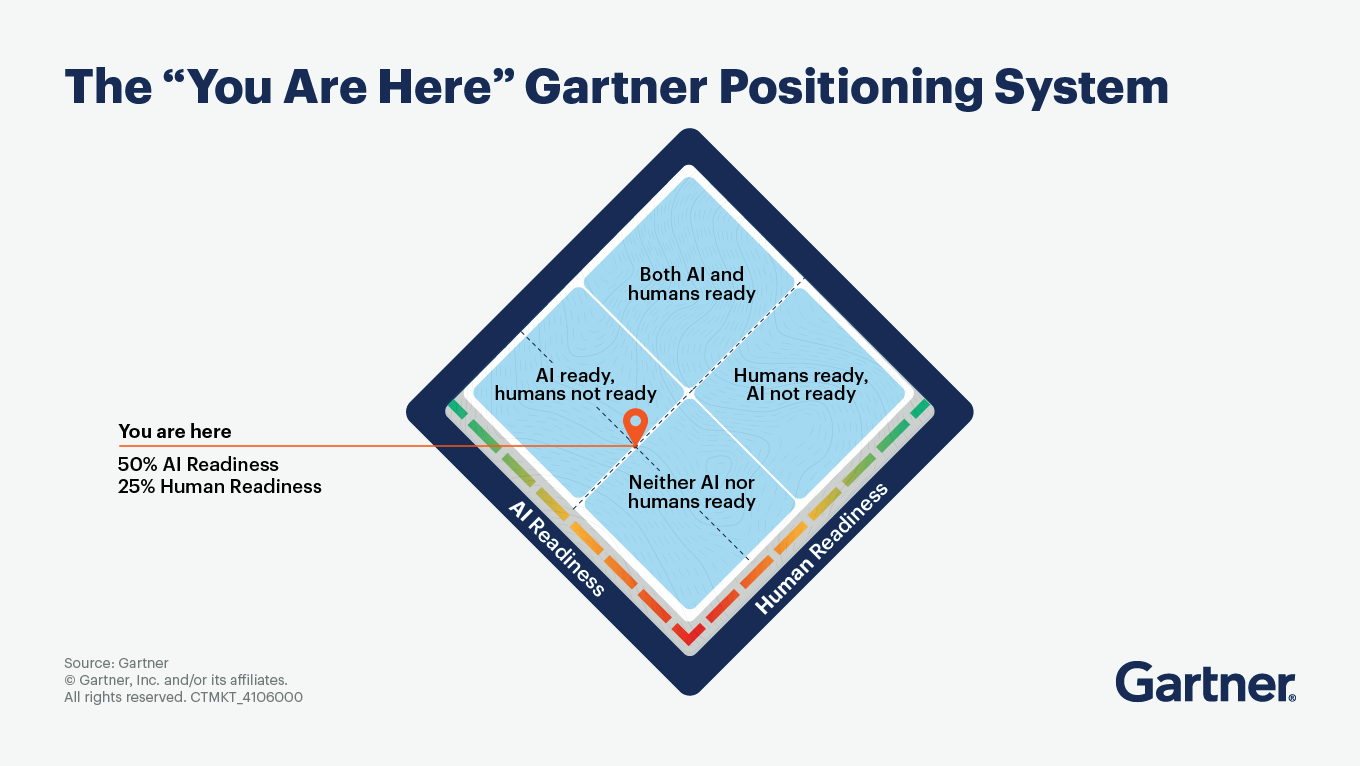Discover highlights from the 2025 Gartner IT Symposium/Xpo opening keynote on how CIOs can unlock and sustain real value by getting both AI and humans ready to transcend limitations.
- Gartner client? Log in for personalized search results.
Finding value in AI initiatives requires a balanced approach
As organizations race to modernize with AI, CIOs stand at a pivotal crossroads. In the Gartner IT Symposium/Xpo keynote in Orlando, FL, Gartner Distinguished VP Analyst and Fellow Daryl Plummer and VP Analyst Alicia Mullery made it clear: The path to greatness lies not in chasing hype or dismissing AI’s potential, but in finding the golden middle ground where value is truly captured. With mounting pressures to show clear ROI value, IT leaders must partner with AI experts and prepare their people to walk this path.
See Gartner insights in action at our CIO conferences and events.
AI readiness is essential for capturing value in IT transformation
AI’s promise is undeniable, but realizing its full value is far from guaranteed. Gartner’s research reveals sobering odds: Only one in five AI initiatives achieve ROI, and just one in fifty deliver true transformation. While AI technology is evolving rapidly, human readiness lags behind. Most organizations invest in productivity gains, but the road to value isn't paved with productivity wins alone.
Human readiness is the missing piece in the AI value equation
While not all AI is ready to deliver value, humans are even less ready to capture value. Despite 87% of employees expressing interest in AI tools, only 32% trust leadership to drive transformation. The imbalance between AI’s technical progress and workforce preparedness creates a fog on the path to value.
CIOs must assess each AI use case for both technology and human readiness, treating them as steps on a “golden path” to success. Readiness is the key that unlocks that next level. Without this balance, organizations risk missing out on AI’s true potential.
Accuracy and decision-making agents are critical for AI success
Technical capabilities like search and content generation are ready, but AI accuracy and autonomous agents remain points of concern. GenAI’s error rates can reach 25% depending on the use case, yet Gartner finds that 84% of CIOs and IT leaders don’t have a formal process to track AI accuracy.
Build an “accuracy survival kit”— including metrics, two-factor error checking and realistic standards — to ensure AI outputs meet business needs. Decision-making agents, not just conversational agents, are essential for unlocking advanced value in areas like B2B negotiation and expert tasks.
Managing costs and choosing the right AI vendors is more complex than ever
AI implementation comes with hidden costs and ongoing training demands. For every AI tool purchased, ten ancillary costs may arise, from data management to model oversight. Vendor selection is now akin to choosing a “digital nation state,” with major hyperscalers and innovative startups offering diverse strengths. CIOs must consider not just technology, but also AI sovereignty and long-term vendor relationships to avoid model lock-in and ensure strategic flexibility.
Building skills and change management to sustain AI value
Human readiness isn’t just about avoiding job losses — it’s about cultivating new skills and managing change. Look for a rise of “Swiss Army Knife” workers who see a problem and have enough curiosity and skill to leverage an AI tool to figure out how to solve it. These workers know how to use AI and can apply AI in any given task. To develop your team into these innovative workers, you need a modern AI literacy program to cultivate new skills like context engineering.
Change management for managers is crucial, as organizations remodel their IT departments for an AI-augmented future. By 2030, 75% of IT work will be done by humans augmented with AI and 25% of the work will be done by AI alone, demanding a proactive approach to identifying new value-creating IT work like expanding into new markets, creating additional products and services, or adding features that boost margins. Elevate your perspective to find, capture and sustain value.
AI and human readiness FAQs
What is the importance of balancing AI and human readiness in IT transformation?
Balancing AI and human readiness is crucial because, while AI technology evolves rapidly, human readiness often lags behind. Without preparing the workforce alongside implementing AI, organizations risk missing out on real value. True transformation and ROI from AI only happen when both technology and people are ready to work together effectively.
How can organizations build human readiness to sustain AI value?
Organizations can build human readiness by investing in modern AI literacy programs and encouraging continuous skill development. Cultivating adaptable employees who can creatively solve problems with AI tools is key. Effective change management and training in new skills, such as context engineering, help teams confidently use AI, ensuring long-term value and innovation.
Attend a Conference
Experience Information Technology conferences
With exclusive insights from Gartner experts on the latest trends, sessions curated for your role and unmatched peer networking, Gartner conferences help you accelerate your priorities.
Gartner CIO Leadership Forum
Phoenix, AZ

Drive stronger performance on your mission-critical priorities.
